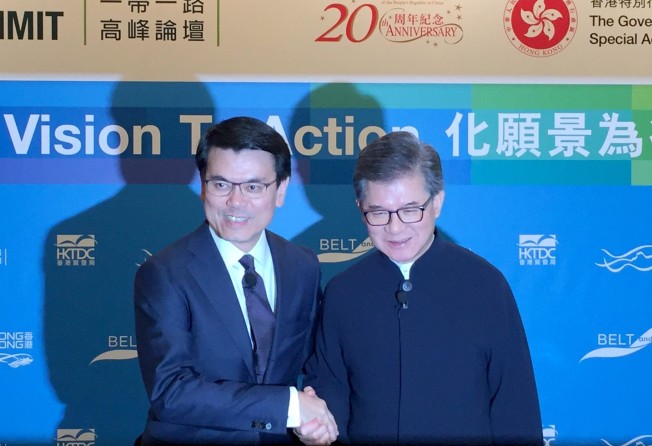Mainland China’s ‘Belt and Road’ trade plan ‘welcomes both big and small Hong Kong companies’
Summit on the scheme expected to draw more than 2,500 people from different countries

The “Belt and Road” trade plan will have room for both big and small businesses, Hong Kong’s top trade body has said, as the city gears up for its second summit on the China-led commerce strategy.
The Belt and Road Summit, jointly organised by the local government and the Trade Development Council, is expected to attract more than 2,500 participants next Monday, bringing together senior government ministers, industry leaders and investors from different countries.
This year’s summit will focus on infrastructure investment and act as a platform for more concrete cooperation and opportunities, council chairman Vincent Lo Hong-sui said.
“No matter how big the investment projects are – even those up to tens of billions of dollars – [these projects] will need the participation of small companies. The big corporations can’t do it all,” Lo said.
Several infrastructure projects have already been set in motion under the initiative since it was launched in Beijing in 2013. The strategy involves nurturing trade routes across Asia, Africa and Europe, connecting more than 60 countries.
The summit will also host a number of project presentations and meetings to match business partners, featuring more than 130 investment projects. It is expected to attract more than 500 project owners.
Investors will be matched with project owners, while participants will be able to network with other country representatives.
The council earlier announced that local companies would form a consortium to help individual firms as well as small and medium-sized enterprises enter developing markets as a collective force. The goal is to build infrastructure for projects in Thailand and Vietnam.
Secretary for Commerce and Economic Development Edward Yau Tang-wah agreed with Lo that large investments did not necessarily mean only big corporations could participate.
“It’s not a matter of numbers, but how professional and internationalised these companies are. Many Hong Kong companies have a competitive advantage given their professional expertise and they are familiar with operating in line with international standards,” Yau said on Monday.
A Hong Kong-based architectural consultancy, Ho and Partners Architects, Engineers and Development Consultants (HPA), is one of the smaller firms that had capitalised on the “Belt and Road” strategy by partnering with a Malaysian firm.
Nicholas Ho, HPA’s deputy managing director, said their company of about 100 staff had started projects in Singapore and Myanmar within four months of merging with the Malaysian design consultancy. They plan to expand to four more cities this year.
“The ‘Belt and Road’ pie is just too big; everyone wants to find more business partners for a piece of it,” Ho said.
Meanwhile, the new Trade and Industry Advisory Board, which advises the government on trade and industry matters, had its first meeting on Monday.
The board comprising 36 members expanded to include the Textiles Advisory Board as well as more business chamber and professional service representatives.
Yau said he hoped the board “with its widened scope and membership” would be “the best platform for the government to consult various stakeholders in the industry”.